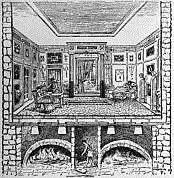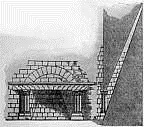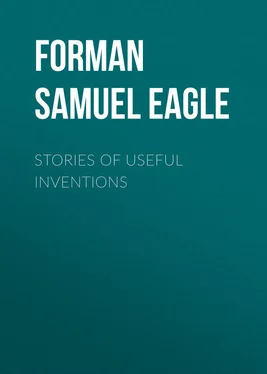Samuel Forman - Stories of Useful Inventions
Здесь есть возможность читать онлайн «Samuel Forman - Stories of Useful Inventions» — ознакомительный отрывок электронной книги совершенно бесплатно, а после прочтения отрывка купить полную версию. В некоторых случаях можно слушать аудио, скачать через торрент в формате fb2 и присутствует краткое содержание. Жанр: foreign_antique, foreign_prose, на английском языке. Описание произведения, (предисловие) а так же отзывы посетителей доступны на портале библиотеки ЛибКат.
- Название:Stories of Useful Inventions
- Автор:
- Жанр:
- Год:неизвестен
- ISBN:нет данных
- Рейтинг книги:5 / 5. Голосов: 1
-
Избранное:Добавить в избранное
- Отзывы:
-
Ваша оценка:
- 100
- 1
- 2
- 3
- 4
- 5
Stories of Useful Inventions: краткое содержание, описание и аннотация
Предлагаем к чтению аннотацию, описание, краткое содержание или предисловие (зависит от того, что написал сам автор книги «Stories of Useful Inventions»). Если вы не нашли необходимую информацию о книге — напишите в комментариях, мы постараемся отыскать её.
Stories of Useful Inventions — читать онлайн ознакомительный отрывок
Ниже представлен текст книги, разбитый по страницам. Система сохранения места последней прочитанной страницы, позволяет с удобством читать онлайн бесплатно книгу «Stories of Useful Inventions», без необходимости каждый раз заново искать на чём Вы остановились. Поставьте закладку, и сможете в любой момент перейти на страницу, на которой закончили чтение.
Интервал:
Закладка:
Early inventions in cooking consisted in simple devices for applying flame directly to the thing which was to be cooked. The first roasting was doubtless done by fastening the flesh to a pole placed in a horizontal position above the fire and supported as is shown in Figure 2. 5 5 Several of the illustrations in this chapter are reproduced through the courtesy of the Boston Stove Co.
The horizontal bar called a spit was originally of wood, but after man had learned to work in metals an iron bar was used. When one side of the flesh was roasted the spit was turned and the other side was exposed to the flames. The spit of the primitive age was the parent of the modern grill and broiler.
Food was first boiled in a hole in the ground. A hole was filled with water into which heated stones were thrown. The stones, by giving off their heat, caused the water to boil in a very short time. After the art of making vessels of clay was learned, food was boiled in earthen pots suspended above the fire.
The methods of warming the house and cooking the food which have just been described were certainly crude and inconvenient, but it was thousands of years before better methods were invented. The long periods of savagery and barbarism passed and the period of civilization was ushered in, but civilization did not at once bring better stoves. Neither the ancient Egyptians nor the ancient Greeks knew how to heat a house comfortably and conveniently. All of them used the primitive stove – a fire on the floor and a hole in the roof. In the house of an ancient Greek there was usually one room which could be heated when there was need, and this was called the "black-room" ( atrium ) – black from the soot and smoke which escaped from the fire on the floor.
But we must not speak harshly of the ancients because they were slow in improving their methods of heating, for in truth the modern world has not done as well in this direction as might have been expected. In a book of travels written only sixty years ago may be found the following passage: "In Normandy, where the cold is severe and fire expensive, the lace-makers, to keep themselves warm and to save fuel, agree with some farmer who has cows in winter quarters to be allowed to carry on their work in the society of the cattle. The cows would be tethered in a long row on one side of the apartment, and the lace-makers sit on the ground on the other side with their feet buried in the straw." Thus the lace-makers kept themselves warm by the heat which came from the bodies of the cattle; the cows, in other words, served as stoves. This barbarous method of heating was practised in some parts of France less than sixty years ago.

FIG. 3. – A ROMAN BRAZIER.
The ancient peoples around the Mediterranean may be excused for not making great progress in the art of heating, for their climate was so mild that they seldom had use for fire in the house. Nevertheless there was in use among these people an invention which has in the course of centuries developed into the stove of to-day. This was the brazier , or warming-pan (Fig. 3). The brazier was filled with burning charcoal and was carried from room to room as it was needed. The unpleasant gases which escaped from the charcoal were made less offensive, but not less unhealthy, by burning perfumes with the fuel. The brazier has never been entirely laid aside. It is still used in Spain and in other warm countries where the necessity for fire is rarely felt.

FIG. 4. – A ROMAN HYPOCAUST.
The brazier satisfied the wants of Greece, but the colder climate of Rome required something better; and in their efforts to invent something better, the ancient Romans made real progress in the art of warming their houses. They built a fire-room – called a hypocaust – in the cellar, and, by means of pipes made of baked clay, they connected the hypocaust with different parts of the house (Fig. 4). Heat and smoke passed up together through these pipes. The poor ancients, it seems, were forever persecuted by smoke. However, after the wood in the hypocaust was once well charred, the smoke was not so troublesome. The celebrated baths (club-rooms) of ancient Rome were heated by means of hypocausts with excellent results. Indeed, the hypocaust had many of the features and many of the merits of our modern furnace. Its weak feature was that it had no separate pipe to carry away the smoke. But as there were no chimneys yet in the world, it is no wonder there was no such pipe.
The Romans made quite as much progress in the art of cooking as they did in the art of heating. Perhaps the world has never seen more skilful cooks than those who served in the mansions of the rich during the period of the Roman Empire (27 B.C. -476 A.D.). In this period the great men at Rome abandoned their plain way of living and became gourmands. One of them wished for the neck of a crane, that he might enjoy for a longer time his food as it descended. This demand for tempting viands developed a race of cooks who were artists in their way. Upon one occasion a king called for a certain kind of fish. The fish could not be had, but the cook was equal to the emergency. "He cut a large turnip to the perfect imitation of the fish desired, and this he fried and seasoned so skilfully that his majesty's taste was exquisitely deceived, and he praised the root to his guests as an excellent fish." Such excellent cooking could not be done on a primitive stove, and along with the improvements in the art of cooking, there was a corresponding improvement at Rome in the art of stove-making.
When Rome fell (476 A.D.), many of the best features of her civilization perished with her. Among the things that were lost to the world were the Roman methods of cooking and heating. When the barbarians came in at the front door, the cooks fled from the kitchen. The hardy northerners had no taste for dainty cooking. Hypocausts ceased to be used, and were no longer built. For several hundred years, in all the countries of Europe, the fireplace was located, as of old, on the floor in the center of the room, while the smoke was allowed to pass out through a hole in the roof.

FIG. 5. – A CHIMNEY AND FIREPLACE IN AN OLD ENGLISH CASTLE.
The eleventh century brought a great improvement in the art of heating, and the improvement came from England. About the time of the Conquest (1066) a great deal of fighting was done on the roofs of English fortresses, and the smoke coming up through the hole in the center of the roof proved to be troublesome to the soldiers. So the fire was moved from the center of the floor to a spot near an outside wall, and an opening was made in the wall just above the fire, so that the smoke could pass out. Here was the origin of the chimney . Projecting from the wall above the fire was a hood, which served to direct the smoke to the opening. At first the opening for the smoke extended but a few feet from the fire, but it was soon found that the further up the wall the opening extended the better was the draft. So the chimney was made to run diagonally up the wall as far as possible. The next and last step in the development of the chimney was to make a recess in the wall as a fireplace, and to build a separate structure of masonry – the chimney – for the smoke. By the middle of the fourteenth century chimneys were usually built in this way (Fig. 5). As the fireplace and chimney cleared the house of soot and smoke, they grew in favor rapidly. By the end of the fifteenth century they were found in the homes of nearly all civilized people.
Читать дальшеИнтервал:
Закладка:
Похожие книги на «Stories of Useful Inventions»
Представляем Вашему вниманию похожие книги на «Stories of Useful Inventions» списком для выбора. Мы отобрали схожую по названию и смыслу литературу в надежде предоставить читателям больше вариантов отыскать новые, интересные, ещё непрочитанные произведения.
Обсуждение, отзывы о книге «Stories of Useful Inventions» и просто собственные мнения читателей. Оставьте ваши комментарии, напишите, что Вы думаете о произведении, его смысле или главных героях. Укажите что конкретно понравилось, а что нет, и почему Вы так считаете.












